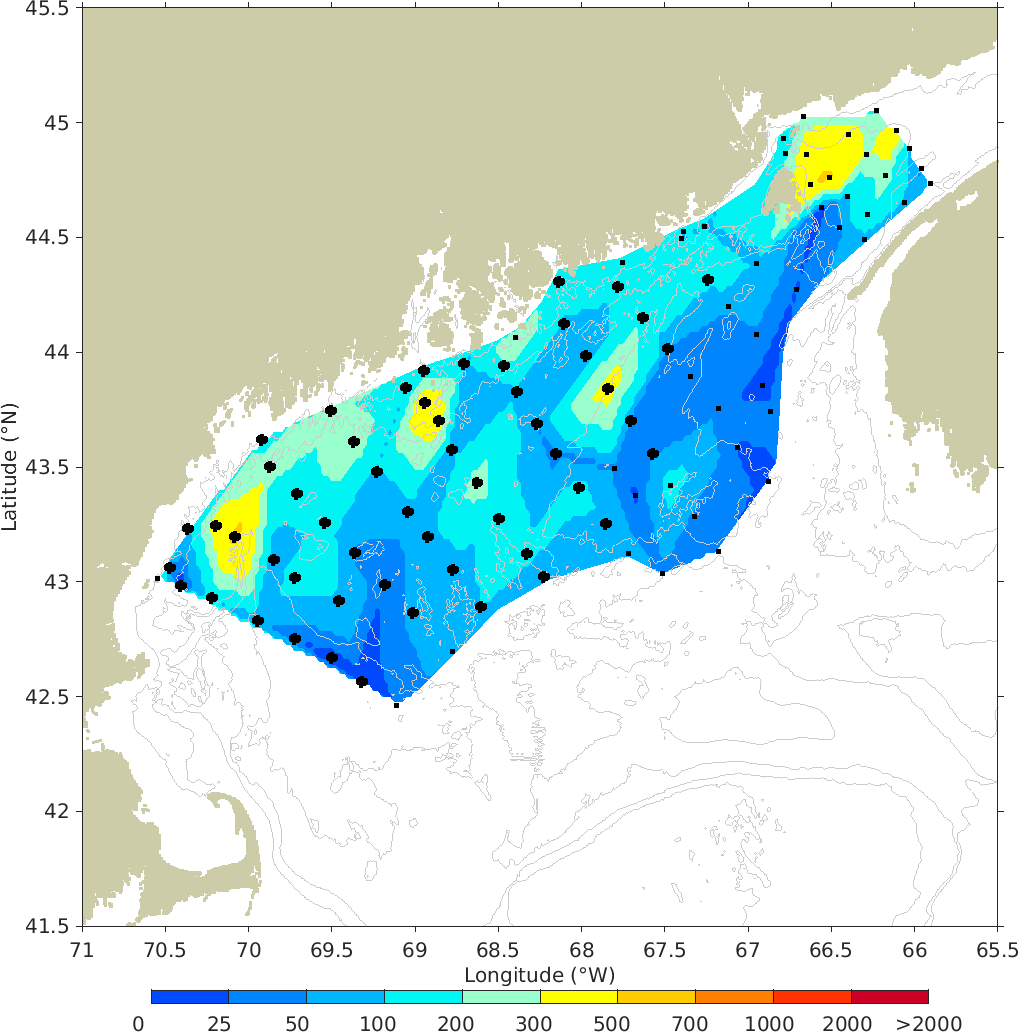Harmful Algal Bloom Forecasts
Experimental Gulf of Maine Alexandrium catenella Nowcast/Forecast Simulation
Results here represent model solutions initiated from a cyst abundance map from October 2020, with germination, growth, and transport of Alexandrium catenella cells driven by the factors listed below. This model is a demonstration, and may not represent actual conditions in the Gulf of Maine.
- Model simulated surface Alexandrium catenella:
- Plan view, Gulf of Maine (averaged over top 10-m meters)
- Plan view, Gulf of Maine (very top model layer)
- Time series at selected locations, New Hampshire coastal waters
- Time series at selected locations, Maine coastal waters
- Cyst map for Alexandrium catenella
- River runoff and meteorological condition outlook in the Gulf of Maine by NOAA Northeast River Forecast Center
2021 Archive - Modeled near-surface Alexandrium catenella bloom
(You may need to refresh your browser or clear your browsing data to see the latest forecast.)

For full animation, please refer to this link for near-surface (averaged over top 10-m) bloom and this link for bloom at surface layer. (new visualizations).
Model simulated surface Alexandrium catenella time series at selected locations, New Hampshire coastal waters
(Refer to Fig.1 below for station locations; blue color is for hindcast, and black color is for forecast. You may need to refresh your browser or clear your browsing data to see the latest forecast. Use playback button for each individual station.)
Model simulated surface Alexandrium catenella time series at selected locations, Maine coastal waters
Refer to Fig.1 below for station locations; blue color is for hindcast, and black color is for forecast. You may need to refresh your browser or clear your browsing data to see the latest forecast. Use playback button for each individual station.)
Very top model layer Alexandrium catenella cell concentrations
(You may need to refresh your browser or clear your browsing data to see the latest forecast.)
Physical circulation model
- ROMS-based Gulf of Maine model on NCSU/WHOI domain (~2-3 km horizontal grid spacing resolution)
- Seven Tidal Constituents (M2, S2, N2, K2, K1, O1, Q1) from driven by ADCIRC tidal forcing in the open boundary (Luettich et al., 1992)
- 6-hourly wind and heat fluxes from NOAA/NCEP NOMADS (~33-km resolution)
- Daily river discharge from Unites States Geological Survey
- Sea surface temperature from NOAA blended SST for surface heat flux correction (https://podaac.jpl.nasa.gov/SeaSurfaceTemperature)
- Initial conditions and open boundary conditions from HYCOM
Alexandrium catenella model
- Population dynamics from Stock et al. (2005); McGillicuddy et al. (2005), He et al., (2008), Li et al.(2009), and Li et al. (in prep.)
- Cyst maps from October 2018 Survey, extrapolated based on Solow et al. (2014)
- Daily Solar radiation used for Alexandrium catenella model derived from NOAA NOMADS to be consistent with physical forcing;
- Monthly climatological nutrient fields from University of Maine (Rebuck and Townsend, 2014)
- The mortality rate of Alexandrium catenella is now parameterized using the temperature dependent Q10 formulation (Durbin and Durbin, 1992).
- The Alexandrium catenella was initiated on March 1 with zero concentration.
References
- Durbin, E. G., & Durbin, A. G. (1992). Effects of temperature and food abundance on grazing and shortterm weight change in the marine copepod Acartia hudsonica. Limnology and Oceanography, 37(2), 361-378.
- He, R., McGillicuddy, D. J., Keafer, B. A., & Anderson, D. M. (2008). Historic 2005 toxic bloom of Alexandrium fundyense in the western Gulf of Maine: 2. Coupled biophysical numerical modeling. Journal of Geophysical Research: Oceans, 113(C7).
- Li, Y., He, R., McGillicuddy, D. J., Anderson, D. M., & Keafer, B. A. (2009). Investigation of the 2006 Alexandrium fundyense bloom in the Gulf of Maine: in-situ observations and numerical modeling. Continental Shelf Research, 29(17), 2069-2082.
- Li et al. (in prep): Diagnosing the 2008 Alexandrium fundyense bloom evolution in the Gulf of Maine.
- Luettich, R.A., Jr., S. Hu, J.J. Westerink, and N.W. Scheffner, 1992, Modeling 3-D Circulation Using Computations for the Western North Atlantic and Gulf of Mexico, Estuarine and Coastal Modeling II, M. Spaulding [ed.], ASCE, pp.632-643.
- McGillicuddy, D. J., Anderson, D. M., Lynch, D. R., & Townsend, D. W. (2005). Mechanisms regulating large-scale seasonal fluctuations in Alexandrium fundyense populations in the Gulf of Maine: results from a physical–biological model. Deep Sea Research Part II: Topical Studies in Oceanography, 52(19), 2698-2714.
- Rebuck, N. D., & Townsend, D. W. (2014). A climatology and time series for dissolved nitrate in the Gulf of Maine region. Deep Sea Research Part II: Topical Studies in Oceanography, 103, 223-237.
- Solow, A. R., Beet, A. R., Keafer, B. A., & Anderson, D. M. (2014). Testing for simple structure in a spatial time series with an application to the distribution of Alexandrium resting cysts in the Gulf of Maine. Marine Ecology Progress Series, 501, 291-296.
- Stock, C. A., McGillicuddy, D. J., Solow, A. R., & Anderson, D. M. (2005). Evaluating hypotheses for the initiation and development of Alexandrium fundyense blooms in the western Gulf of Maine using a coupled physical–biological model. Deep Sea Research Part II: Topical Studies in Oceanography, 52(19), 2715-2744.
Disclaimer: This result is for experimental only. For questions, please email Yizhen Li or Richard Stumpf.
Fig.1. Abundance for top 1-cm sediment layer collected in October, 2020 (cells/cm2). Bold dots stand for the stations of cyst sampling, and light dots represent stations where cysts were extrapolated to. Crosses represent the location where routine shellfish toxicity was monitored during the bloom season. The cyst map was generated through extrapolation following Solow et al. (2014).
 Official websites use .gov
A .gov website belongs to an official government organization in the United States.
Official websites use .gov
A .gov website belongs to an official government organization in the United States. Secure .gov websites use HTTPS
A lock or https:// means you’ve safely connected to the .gov website. Share sensitive information only on official, secure websites.
Secure .gov websites use HTTPS
A lock or https:// means you’ve safely connected to the .gov website. Share sensitive information only on official, secure websites.